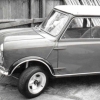A Kent 266 cam works at a recommended inlet timing of 106 degres AFTD (after top dead centre). Lte's assume that the cam and crank sprockets are fitted and the timing chain is also on with the sprockets lined up dot-to-dot.
Fit a crankshaft protractor to the end of the crankshaft and bring pistons1 & 4 accurately to TDC. Establish on which cylinder it is firing. Set the protractor to zero using a suitable datum point.
Place the DTI on the inlet push rod of the firing cylinder or, if the head is fitted, on the inlet valve cap of that cylinder.
Rotate the engine clockwise until the DTI is shaowing maximum valve opening. Turn the crank back until it is 10 thou below maximum then slowly rotate it clockwise until it is reading exactly 5 thou less than the maximum reading you just had. Note the degrees on the protractor. Continue to rotate the engine clockwise until the DTI has read maximum and then dropped back to exactly 5 thou less than maximum. Again read of the angle.
The cam timing is half way between these two figures. For example, if the first reading is 96 degrees and the second reading is 118 degrees, the difference is 24 degrees. Half of 24 is 12 degrees which, when added to 96 gives a cam timing of 108 degrees, so it is 2 degrees retarded from the ideal.
If you ahve just fitted a new timing chain the ideal is to set to 2 degrees advanced (i.e. 104 degs) to allow for initial chain stretch.
For cam timing adjustment you can use either a vernier sprocket or an offset woodruff key.
I usually repeat the measuring 3 times to get the best average as it will vary by a degree or so each time due to measuring error.
You really can't do this without a DTI, but they are not expensive.
Edited by Cooperman, 10 June 2020 - 11:08 PM.
















